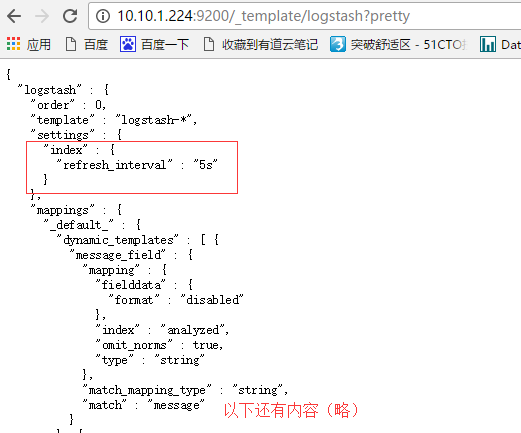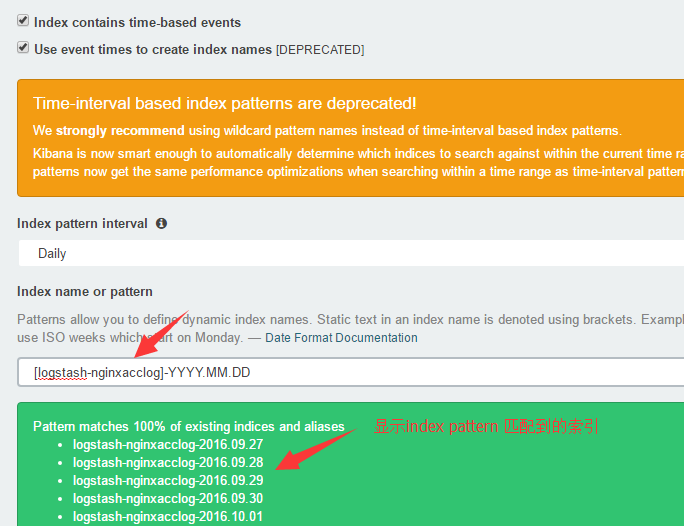原創作品,允許轉載,轉載時請務必以超鏈接形式標明文章 原始出處 、作者信息和本聲明。否則將追究法律責任。http://tchuairen.blog.51cto.com/3848118/1861167
什麼要做日誌分析平臺?
隨着業務量的增長,每天業務服務器將會產生上億條的日誌,單個日誌文件達幾個GB,這時我們發現用Linux自帶工具,cat grep awk 分析越來越力不從心了,而且除了服務器日誌,還有程序報錯日誌,分佈在不同的服務器,查閱繁瑣。
待解決的痛點:
1、大量不同種類的日誌成爲了運維人員的負擔,不方便管理;
2、單個日誌文件巨大,無法使用常用的文本工具分析,檢索困難;
3、日誌分佈在多臺不同的服務器上,業務一旦出現故障,需要一臺臺查看日誌。
爲了解決以上困擾:
接下來我們要一步步構建這個日誌分析平臺,架構圖如下:
架構解讀 : (整個架構從左到右,總共分爲5層)
第一層、數據採集層
最左邊的是業務服務器集羣,上面安裝了filebeat做日誌採集,同時把採集的日誌分別發送給兩個logstash服務。
第二層、數據處理層,數據緩存層
logstash服務把接受到的日誌經過格式處理,轉存到本地的kafka broker+zookeeper 集羣中。
第三層、數據轉發層
這個單獨的Logstash節點會實時去kafka broker集羣拉數據,轉發至ES DataNode。
第四層、數據持久化存儲
ES DataNode 會把收到的數據,寫磁盤,建索引庫。
第五層、數據檢索,數據展示
ES Master + Kibana 主要協調ES集羣,處理數據檢索請求,數據展示。
筆者爲了節約寶貴的服務器資源,把一些可拆分的服務合併在同一臺主機。大家可以根據自己的實際業務環境自由拆分,延伸架構。
開 工 !
操作系統環境 : CentOS release 6.5
各服務器角色分配 :
| IP | 角色 | 所屬集羣 |
| 10.10.1.2 | 業務服務器+filebeat | 業務服務器集羣 |
| 10.10.1.30 | Logstash+Kafka+ZooKeeper | Kafka Broker 集羣 |
| 10.10.1.31 | Logstash+Kafka+ZooKeeper | |
| 10.10.1.32 | Kafka+ZooKeeper | |
| 10.10.1.50 | Logstash | 數據轉發 |
| 10.10.1.60 | ES DataNode | Elasticsearch 集羣 |
| 10.10.1.90 | ES DataNode | |
| 10.10.1.244 | ES Master+Kibana |
軟件包版本:
jdk-8u101-linux-x64.rpm
logstash-2.3.2.tar.gz
filebeat-1.2.3-x86_64.rpm
kafka_2.11-0.10.0.1.tgz
zookeeper-3.4.9.tar.gz
elasticsearch-2.3.4.rpm
kibana-4.5.3-linux-x64.tar.gz
一、安裝部署Elasticsearch集羣
佈置ES Master節點 10.10.1.244
1、安裝jdk1.8,elasticsearch-2.3.4
oracle官網 jdk 下載地址: http://www.oracle.com/technetwork/java/javase/downloads/index.html
elasticsearch 官網: https://www.elastic.co/
1 2 3 4 | # 安裝命令yum install jdk-8u101-linux-x64.rpm elasticsearch-2.3.4.rpm -y# ES 會被默認安裝在 /usr/share/elasticsearch/ |
2、系統調優,JVM調優
1 2 3 4 5 6 7 8 9 10 11 12 13 14 | # 配置系統最大打開文件描述符數vim /etc/sysctl.conffs.file-max=65535# 配置進程最大打開文件描述符vim /etc/security/limits.conf# End of file* soft nofile 65535* hard nofile 65535# 配置 JVM內存vim /etc/sysconfig/elasticsearchES_HEAP_SIZE=4g# 這臺機器的可用內存爲8G |
3、編寫ES Master節點配置文件
1 2 3 4 5 6 7 8 9 10 11 12 13 14 15 16 17 18 19 20 21 22 23 24 25 26 27 28 29 30 31 32 33 34 35 36 37 38 39 40 41 42 43 44 | # /etc/elasticsearch/elasticsearch.yml# ---------------------------------- Cluster -----------------------------------# Use a descriptive name for your cluster:cluster.name: bigdata# ------------------------------------ Node ------------------------------------node.name: server1node.master: truenode.data: false# ----------------------------------- Index ------------------------------------index.number_of_shards: 5index.number_of_replicas: 0index.refresh_interval: 120s# ----------------------------------- Paths ------------------------------------path.data: /home/elk/datapath.logs: /var/log/elasticsearch/elasticsearch.log# ----------------------------------- Memory -----------------------------------bootstrap.mlockall: trueindices.fielddata.cache.size: 50mb#------------------------------------ Network And HTTP --------------------------network.host: 0.0.0.0http.port: 9200# ------------------------------------ Translog ----------------------------------index.translog.flush_threshold_ops: 50000# --------------------------------- Discovery ------------------------------------discovery.zen.minimum_master_nodes: 1discovery.zen.ping.timeout: 200sdiscovery.zen.fd.ping_timeout: 200sdiscovery.zen.fd.ping.interval: 30sdiscovery.zen.fd.ping.retries: 6discovery.zen.ping.unicast.hosts: ["10.10.1.60:9300","10.10.1.90:9300","10.10.1.244:9300",]discovery.zen.ping.multicast.enabled: false# --------------------------------- merge ------------------------------------------indices.store.throttle.max_bytes_per_sec: 100mb |
注: path.data、path.logs 這兩個參數指定的路徑,如果沒有需要自己創建,還要賦予權限給elasticsearch用戶。(後面的ES DataNode也同樣)
4、安裝head、kopf、bigdesk 開源插件
安裝方法有兩種 :
1、使用ES自帶的命令plugin
1 2 3 4 5 6 | # head/usr/share/elasticsearch/bin/plugin install mobz/elasticsearch-head# kopf/usr/share/elasticsearch/bin/plugin install lmenezes/elasticsearch-kopf# bigdesk/usr/share/elasticsearch/bin/plugin install hlstudio/bigdesk |
2、自行下載插件的源碼包安裝
我們通過plugin命令安裝的插件,其實是安裝到了這個路徑:/usr/share/elasticsearch/plugins
而plugin install 命令後面跟的這一串 mobz/elasticsearch-head 其實是github上的一個地址。
前面加上github的官網地址就是 https://github.com/mobz/elasticsearch-head 可以複製到瀏覽器中打開,找到該插件的源碼倉庫。
現在知道了,想要找插件自己可以去github上搜一下出來一大堆。隨便選一個然後取後面那串路徑,用ES自帶的命令安裝。
如果安裝失敗了,那麼就手動下載該插件的源碼包。 解壓後直接整個目錄mv到 ES 的插件安裝路徑下。
也就是這裏: /usr/share/elasticsearch/plugins/
那如何訪問安裝好的插件呢?
http://ES_server_ip:port/_plugin/plugin_name
Example:
http://127.0.0.1:9200/_plugin/head/
http://127.0.0.1:9200/_plugin/kopf/
這時,ES Master已經配置好了。
佈置ES DataNode節點 10.10.1.60
安裝和系統調優方法同上,插件不用安裝,只是配置文件不同。
編寫配置文件
1 2 3 4 5 6 7 8 9 10 11 12 13 14 15 16 17 18 19 20 21 22 23 24 25 26 27 28 29 30 31 32 33 34 35 36 37 38 39 40 41 42 | # ---------------------------------- Cluster -----------------------------------# Use a descriptive name for your cluster:cluster.name: bigdata# ------------------------------------ Node ------------------------------------node.name: server2node.master: falsenode.data: true# ----------------------------------- Index ------------------------------------index.number_of_shards: 5index.number_of_replicas: 0index.refresh_interval: 120s# ----------------------------------- Paths ------------------------------------path.data: /home/elk/data,/disk2/elk/data2path.logs: /var/log/elasticsearch/elasticsearch.log# ----------------------------------- Memory -----------------------------------bootstrap.mlockall: trueindices.fielddata.cache.size: 50mb#------------------------------------ Network And HTTP --------------------------network.host: 0.0.0.0http.port: 9200# ------------------------------------ Translog ----------------------------------index.translog.flush_threshold_ops: 50000# --------------------------------- Discovery ------------------------------------discovery.zen.minimum_master_nodes: 1discovery.zen.ping.timeout: 200sdiscovery.zen.fd.ping_timeout: 200sdiscovery.zen.fd.ping.interval: 30sdiscovery.zen.fd.ping.retries: 6discovery.zen.ping.unicast.hosts: ["10.10.1.244:9300",]discovery.zen.ping.multicast.enabled: false# --------------------------------- merge ------------------------------------------indices.store.throttle.max_bytes_per_sec: 100mb |
10.10.1.60 也準備好了。
佈置另一臺ES DataNode節點 10.10.1.90
編寫配置文件
1 2 3 4 5 6 7 8 9 10 11 12 13 14 15 16 17 18 19 20 21 22 23 24 25 26 27 28 29 30 31 32 33 34 35 36 37 38 39 40 41 42 | # ---------------------------------- Cluster -----------------------------------# Use a descriptive name for your cluster:cluster.name: bigdata# ------------------------------------ Node ------------------------------------node.name: server3node.master: falsenode.data: true# ----------------------------------- Index ------------------------------------index.number_of_shards: 5index.number_of_replicas: 0index.refresh_interval: 120s# ----------------------------------- Paths ------------------------------------path.data: /home/elk/singlepath.logs: /var/log/elasticsearch/elasticsearch.log# ----------------------------------- Memory -----------------------------------bootstrap.mlockall: trueindices.fielddata.cache.size: 50mb#------------------------------------ Network And HTTP --------------------------network.host: 0.0.0.0http.port: 9200# ------------------------------------ Translog ----------------------------------index.translog.flush_threshold_ops: 50000# --------------------------------- Discovery ------------------------------------discovery.zen.minimum_master_nodes: 1discovery.zen.ping.timeout: 200sdiscovery.zen.fd.ping_timeout: 200sdiscovery.zen.fd.ping.interval: 30sdiscovery.zen.fd.ping.retries: 6discovery.zen.ping.unicast.hosts: ["10.10.1.244:9300",]discovery.zen.ping.multicast.enabled: false# --------------------------------- merge ------------------------------------------indices.store.throttle.max_bytes_per_sec: 100mb |
5、現在三臺ES節點已經準備就緒,分別啓動服務
1 2 3 4 5 6 | # 10.10.1.244/etc/init.d/elasticsearch start# 10.10.1.60/etc/init.d/elasticsearch start# 10.10.1.90/etc/init.d/elasticsearch start |
6、訪問head插件,查看集羣狀態
此時 Elasticsearch 集羣已經準備完成
二、配置位於架構圖中第二層的ZooKeeper集羣
配置 10.10.1.30 節點
1、安裝,配置 zookeeper
zookeeper官網: http://zookeeper.apache.org/
1 2 3 4 5 | # zookeeper 依賴 java,如果之前沒安裝過JDK,則需要安裝.rpm -ivh jdk-8u101-linux-x64.rpm# 解壓程序tar xf zookeeper-3.4.9.tar.gz |
編寫配置文件
1 2 3 4 5 6 7 8 9 10 11 12 13 14 15 16 17 18 19 20 21 22 23 24 25 26 27 28 29 30 31 32 33 34 | # conf/zoo.cfg# The number of milliseconds of each ticktickTime=2000# The number of ticks that the initial # synchronization phase can takeinitLimit=10# The number of ticks that can pass between # sending a request and getting an acknowledgementsyncLimit=5# the directory where the snapshot is stored.# do not use /tmp for storage, /tmp here is just # example sakes.dataDir=/u01/zookeeper/zookeeper-3.4.9/data# the port at which the clients will connectclientPort=2181# the maximum number of client connections.# increase this if you need to handle more clients#maxClientCnxns=60server.11=10.10.1.30:2888:3888server.12=10.10.1.31:2888:3888server.13=10.10.1.32:2888:3888# Be sure to read the maintenance section of the # administrator guide before turning on autopurge.## http://zookeeper.apache.org/doc/current/zookeeperAdmin.html#sc_maintenance## The number of snapshots to retain in dataDir# autopurge.snapRetainCount=3# Purge task interval in hours# Set to "0" to disable auto purge feature# autopurge.purgeInterval=1 |
同步配置文件到其他兩臺節點
注: zookeeper 集羣,每個節點的配置文件都是一樣的。所以直接同步過去,不需要做任何修改。
不熟悉zookeeper的朋友,可以參考這裏: http://tchuairen.blog.51cto.com/3848118/1859494
1 2 | scp zoo.cfg 10.10.1.31:/usr/local/zookeeper-3.4.9/conf/scp zoo.cfg 10.10.1.32:/usr/local/zookeeper-3.4.9/conf/ |
2、創建myid文件
1 2 3 4 5 6 7 8 | # 10.10.1.30echo 11 >/usr/local/zookeeper-3.4.9/data/myid# 10.10.1.31echo 12 >/usr/local/zookeeper-3.4.9/data/myid# 10.10.1.32echo 13 >/usr/local/zookeeper-3.4.9/data/myid |
3、啓動服務 & 查看節點狀態
1 2 3 4 5 6 7 8 9 10 11 12 13 14 15 16 17 18 19 20 21 22 23 | # 10.10.1.30bin/zkServer.sh startbin/zkServer.sh statusZooKeeper JMX enabled by defaultUsing config: /usr/local/zookeeper/zookeeper-3.4.9/bin/../conf/zoo.cfgMode: leader# 10.10.1.31bin/zkServer.sh startbin/zkServer.sh status ZooKeeper JMX enabled by defaultUsing config: /usr/local/zookeeper/zookeeper-3.4.9/bin/../conf/zoo.cfgMode: follower# 10.10.1.32bin/zkServer.sh start bin/zkServer.sh statusZooKeeper JMX enabled by defaultUsing config: /usr/local/zookeeper/zookeeper-3.4.9/bin/../conf/zoo.cfgMode: follower |
此時zookeeper集羣配置完成
三、配置位於架構圖中第二層的Kafka Broker集羣
Kafka官網: http://kafka.apache.org/
不熟悉Kafka的朋友可以參考: http://tchuairen.blog.51cto.com/3848118/1855090
配置 10.10.1.30 節點
1、安裝,配置 kafka
1 2 | # 解壓程序tar xf kafka_2.11-0.10.0.1.tgz |
編寫配置文件
1 2 3 4 5 6 7 8 9 10 11 12 13 14 15 16 17 18 19 20 21 22 23 24 25 26 27 28 29 30 31 32 33 34 35 36 37 38 39 40 41 42 43 44 45 46 47 48 | ############################# Server Basics #############################broker.id=1############################# Socket Server Settings #############################num.network.threads=3# The number of threads doing disk I/Onum.io.threads=8# The send buffer (SO_SNDBUF) used by the socket serversocket.send.buffer.bytes=102400# The receive buffer (SO_RCVBUF) used by the socket serversocket.receive.buffer.bytes=102400# The maximum size of a request that the socket server will accept (protection against OOM)socket.request.max.bytes=104857600############################# Log Basics #############################log.dirs=/usr/local/kafka/kafka_2.11-0.10.0.1/datanum.partitions=6num.recovery.threads.per.data.dir=1############################# Log Flush Policy ############################## The number of messages to accept before forcing a flush of data to disk#log.flush.interval.messages=10000# The maximum amount of time a message can sit in a log before we force a flush#log.flush.interval.ms=1000############################# Log Retention Policy #############################log.retention.hours=60log.segment.bytes=1073741824log.retention.check.interval.ms=300000############################# Zookeeper #############################zookeeper.connect=10.10.1.30:2181,10.10.1.31:2181,10.10.1.32:2181zookeeper.connection.timeout.ms=6000 |
注: 其他兩個節點的配置文件也基本相同,只有一個參數需要修改 broker.id 。 它用於唯一標識節點,所以絕對不能相同,不然會節點衝突。
同步配置文件到其他兩臺節點
1 2 3 4 5 6 7 8 9 | scp server.properties 10.10.1.31:/usr/local/kafka/kafka_2.11-0.10.0.1/config/scp server.properties 10.10.1.32:/usr/local/kafka/kafka_2.11-0.10.0.1/config/# 修改 broker.id# 10.10.1.31broker.id=2# 10.10.1.32broker.id=3 |
2、配置主機名對應IP的解析
1 2 3 4 5 6 7 | vim /etc/hosts10.10.1.30 server110.10.1.31 server210.10.1.32 server3# 記得同步到其他兩臺節點 |
3、啓動服務
1 2 | bin/kafka-server-start.sh config/server.properties# 其他兩臺節點啓動方式相同 |
Kafka+ZooKeeper集羣配置完成
四、配置位於架構圖中第二層的Logstash服務
配置 10.10.1.30 節點
1、安裝,配置 logstash
1 2 | # 解壓程序tar xf logstash-2.3.2.tar.gz |
配置 GeoLiteCity , 用於地圖顯示IP訪問的城市
官網地址: http://dev.maxmind.com/geoip/legacy/geolite/
下載地址: http://geolite.maxmind.com/download/geoip/database/GeoLiteCity.dat.gz
解壓
gunzip GeoLiteCity.dat.gz
編寫配置文件
1 2 3 4 5 6 7 8 9 10 11 12 13 14 15 16 17 18 19 20 21 22 23 24 25 26 27 28 29 30 31 32 33 34 35 36 37 38 39 40 41 42 | input { beats { port => 5044 codec => "json"}}filter { if [type] == "nginxacclog" { geoip { source => "clientip" # 與日誌中訪問地址的key要對應 target => "geoip" database => "/usr/local/logstash/GeoLiteCity.dat" add_field => [ "[geoip][coordinates]","%{[geoip][longitude]}" ] add_field => [ "[geoip][coordinates]","%{[geoip][latitude]}" ]} mutate { convert => [ "[geoip][coordinates]","float" ]}}}output { kafka { workers => 2 bootstrap_servers => "10.10.1.30:9092,10.10.1.31:9092,10.10.1.32:9092" topic_id => "peiyinlog"}} |
2、啓動服務
1 | /usr/local/logstash/bin/logstash agent -f logstash_in_kafka.conf & |
10.10.1.31 節點的這塊配置,與上述完全相同。(略)
位於第二層、數據處理層的 Logstash 配置完成
五、配置數據採集層,業務服務器+Filebeat
1、定製Nginx日誌格式
1 2 3 4 5 6 7 8 9 10 11 12 13 14 15 16 17 18 | log_format json '{"@timestamp":"$time_iso8601",' '"slbip":"$remote_addr",' '"clientip":"$http_x_forwarded_for",' '"serverip":"$server_addr",' '"size":$body_bytes_sent,' '"responsetime":$request_time,' '"domain":"$host",' '"method":"$request_method",' '"requesturi":"$request_uri",' '"url":"$uri",' '"appversion":"$HTTP_APP_VERSION",' '"referer":"$http_referer",' '"agent":"$http_user_agent",' '"status":"$status",' '"devicecode":"$HTTP_HA"}'; # 在虛擬主機配置中調用access_log /alidata/log/nginx/access/access.log json; |
2、安裝 Filebeat
Filebeat 也是 Elasticsearch 公司的產品,在官網可以下載。
1 2 | # rpm 包安裝yum install filebeat-1.2.3-x86_64.rpm -y |
3、編寫 Filebeat 配置文件
1 2 3 4 5 6 7 8 9 10 11 12 13 14 15 16 17 18 19 20 21 22 23 24 25 26 27 28 29 30 31 32 33 34 35 36 37 38 39 40 41 42 43 44 45 46 47 48 49 50 51 52 53 54 55 56 57 58 59 60 61 62 63 64 65 66 67 68 69 70 71 72 73 74 75 76 77 78 79 80 81 82 83 84 85 86 87 88 | ################### Filebeat Configuration Example ###################################################### Filebeat ######################################filebeat: prospectors: - paths: - /var/log/messages input_type: log document_type: messages - paths: - /alidata/log/nginx/access/access.log input_type: log document_type: nginxacclog - paths: - /alidata/www/logs/laravel.log input_type: log document_type: larlog - paths: - /alidata/www/logs/500_error.log input_type: log document_type: peiyinlar_500error - paths: - /alidata/www/logs/deposit.log input_type: log document_type: lar_deposit - paths: - /alidata/www/logs/call_error.log input_type: log document_type: call_error - paths: - /alidata/log/php/php-fpm.log.slow input_type: log document_type: phpslowlog multiline: pattern: '^[[:space:]]' negate: true match: after registry_file: /var/lib/filebeat/registry ############################# Output ########################################## output: logstash: hosts: ["10.26.95.215:5044"] ############################# Shipper ######################################### shipper: name: "host_6" ############################# Logging ######################################### logging: files: rotateeverybytes: 10485760 # = 10MB |
4、啓動服務
1 | /etc/init.d/filebeat start |
數據採集層,Filebeat配置完成。
現在業務服務器上的日誌數據已經在源源不斷的寫入緩存了。
六、配置位於架構圖中的第三層,數據轉發層
Logstash安裝上面已經講過(略)
編寫Logstash配置文件
1 2 3 4 5 6 7 8 9 10 11 12 13 14 15 16 17 18 19 20 21 22 23 24 25 26 27 28 29 30 31 32 33 34 35 36 37 38 39 40 41 42 43 44 45 46 47 48 49 50 51 52 53 54 55 56 57 58 59 60 61 62 63 64 65 66 67 68 69 70 71 72 73 74 75 76 77 78 79 80 81 82 83 84 85 86 87 88 89 90 91 92 | # kafka_to_es.confinput{ kafka { zk_connect => "10.10.1.30:2181,10.10.1.31:2181,10.10.1.32:2181" group_id => "logstash" topic_id => "peiyinlog" reset_beginning => false consumer_threads => 50 decorate_events => true}}# 刪除一些不需要的字段filter { if [type] == "nginxacclog" { mutate { remove_field => ["slbip","kafka","domain","serverip","url","@version","offset","input_type","count","source","fields","beat.hostname","host","tags"] }}}output { if [type] == "nginxacclog" { # stdout {codec => rubydebug } elasticsearch { hosts => ["10.10.1.90:9200","10.10.1.60:9200"] index => "logstash-nginxacclog-%{+YYYY.MM.dd}" manage_template => true flush_size => 50000 idle_flush_time => 10 workers => 2}} if [type] == "messages" { elasticsearch { hosts => ["10.10.1.90:9200","10.10.1.60:9200"] index => "logstash-messages-%{+YYYY.MM.dd}" manage_template => true flush_size => 50000 idle_flush_time => 30 workers => 1}} if [type] == "larlog" { elasticsearch { hosts => ["10.10.1.90:9200","10.10.1.60:9200"] index => "logstash-larlog-%{+YYYY.MM.dd}" manage_template => true flush_size => 2000 idle_flush_time => 10}} if [type] == "deposit" { elasticsearch { hosts => ["10.10.1.90:9200","10.10.1.60:9200"] index => "logstash-deposit-%{+YYYY.MM.dd}" manage_template => true flush_size => 2000 idle_flush_time => 10}} if [type] == "phpslowlog" { elasticsearch { hosts => ["10.10.1.90:9200","10.10.1.60:9200"] index => "logstash-phpslowlog-%{+YYYY.MM.dd}" manage_template => true flush_size => 2000 idle_flush_time => 10}}} |
啓動服務
1 | /usr/local/logstash/bin/logstash agent -f kafka_to_es.conf & |
數據轉發層已經配置完成
這時數據已經陸陸續續的從kafka取出,轉存到ES DataNode。
我們登陸到任意一臺kafka主機,查看數據的緩存和消費情況
七、修改ES的索引模版配置
爲什麼要做這一步呢? 因爲logstash寫入數據到ES時,會自動選用一個索引模版。 我們可以看一下
這個模版其實也挺好,不過有一個參數,我標記出來了。 "refresh_interval":"5s" 這個參數用於控制,索引的刷新頻率。 索引的刷新頻率越快,你搜索到的數據就實時。 這裏是5秒。 一般我們日誌場景不需要這麼高的實時性。 可以適當降低該參數,提高ES 索引庫的寫入速度。
上傳自定義模版
1 2 3 4 5 6 7 8 9 10 11 12 13 14 15 16 17 | curl -XPUT http://10.10.1.244:9200/_template/logstash2 -d '{ "order":1, "template":"logstash-*", "settings":{ "index":{ "refresh_interval":"120s" } }, "mappings":{ "_default_":{ "_all":{ "enabled":false } } }}' |
由於這個自定義模版,我把優先級 order 定義的比logstash模版高,而模版的匹配規則又一樣,所以這個自定義模版的配置會覆蓋原logstash模版。
我這裏只是簡單描述。 如果要詳細理解其中道理,請查看我的 ES 調優篇。
八、配置 Kibana 數據展示層
10.10.1.244 節點
Kibana是ELK套件中的一員,也屬於elasticsearch 公司,在官網提供下載。
安裝
1 2 | tar xf kibana-4.5.3-linux-x64.tar.gz# 很簡單,只要解壓就可以用。 |
修改配置文件
1 2 3 4 5 6 7 8 9 10 11 12 | # vim kibana-4.5.3-linux-x64/config/kibana.yml# Kibana is served by a back end server. This controls which port to use.server.port: 5601# The host to bind the server to.server.host: "0.0.0.0"# The Elasticsearch instance to use for all your queries.elasticsearch.url: "# 修改這三個參數就好了 |
啓動服務
打開瀏覽器訪問: http://10.10.1.244:5601/
定製 Elasticsearch 索引的 Index pattern
默認情況下,Kibana認爲你要訪問的是通過Logstash導入Elasticsearch的數據,這時候你可以用默認的 logstash-* 作爲你的 index pattern。 通配符(*)匹配索引名中任意字符任意個數。
選擇一個包含了時間戳的索引字段(字段類型爲 date 的字段),可以用來做基於時間的處理。Kibana 會讀取索引的
映射,然後列出所有包含了時間戳的字段。如果你的索引沒有基於時間的數據.
關閉 Index contains time-based events 參數。
如果一個新索引是定期生成,而且索引名中帶有時間戳,選擇 Use event times to create index names 選項,
然後再選擇 Index pattern interval 。這可以提高搜索性能,Kibana 會至搜索你指定的時間範圍內的索引。在你用 Logstash 輸出數據給Elasticsearch 的情況下尤其有效。
由於我們的索引是用日期命名,按照每天分割的。 index pattern 如下
數據展示
完 工 !
本文出自 “突破舒適區” 博客,請務必保留此出處http://tchuairen.blog.51cto.com/3848118/1861167







